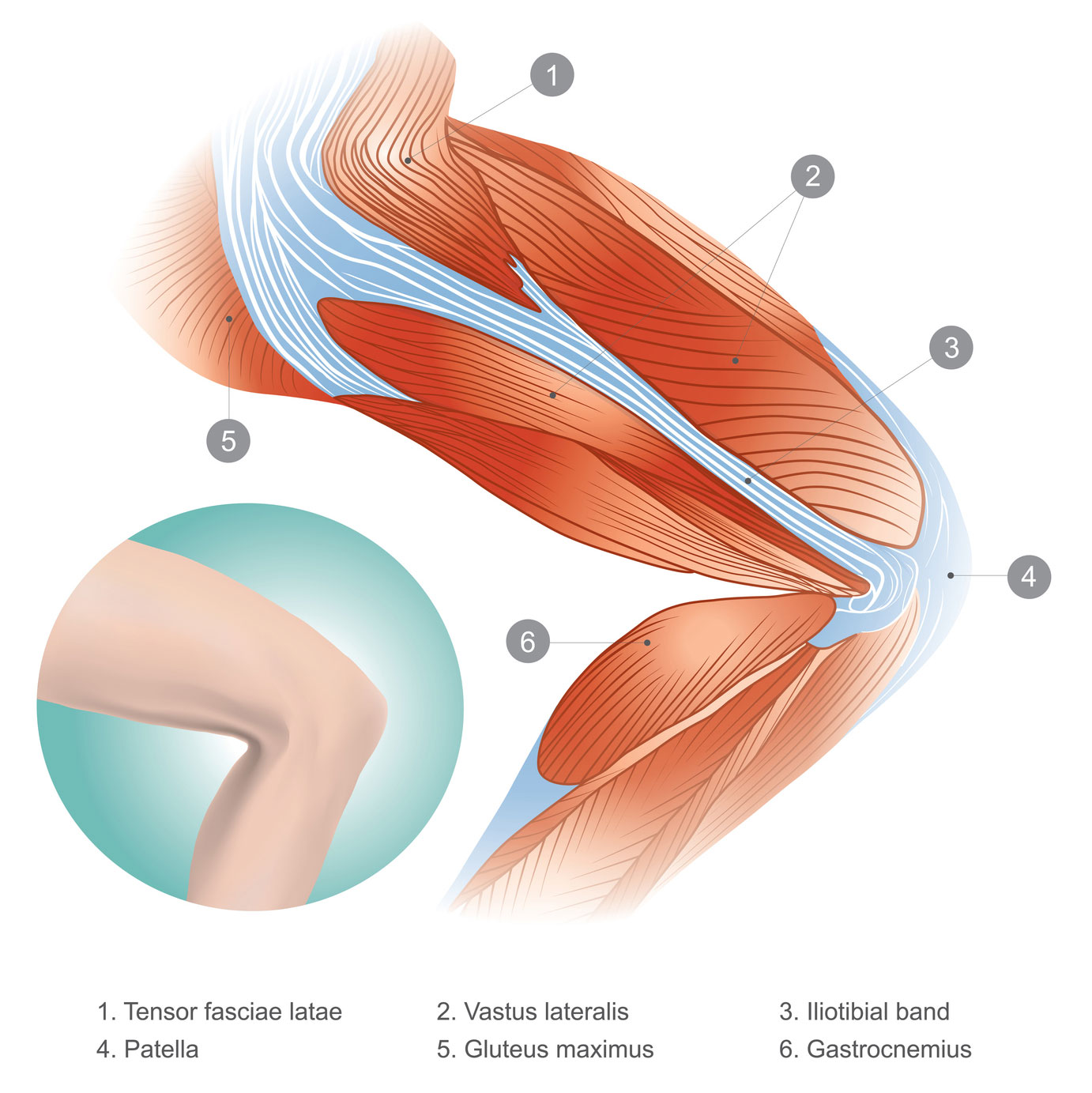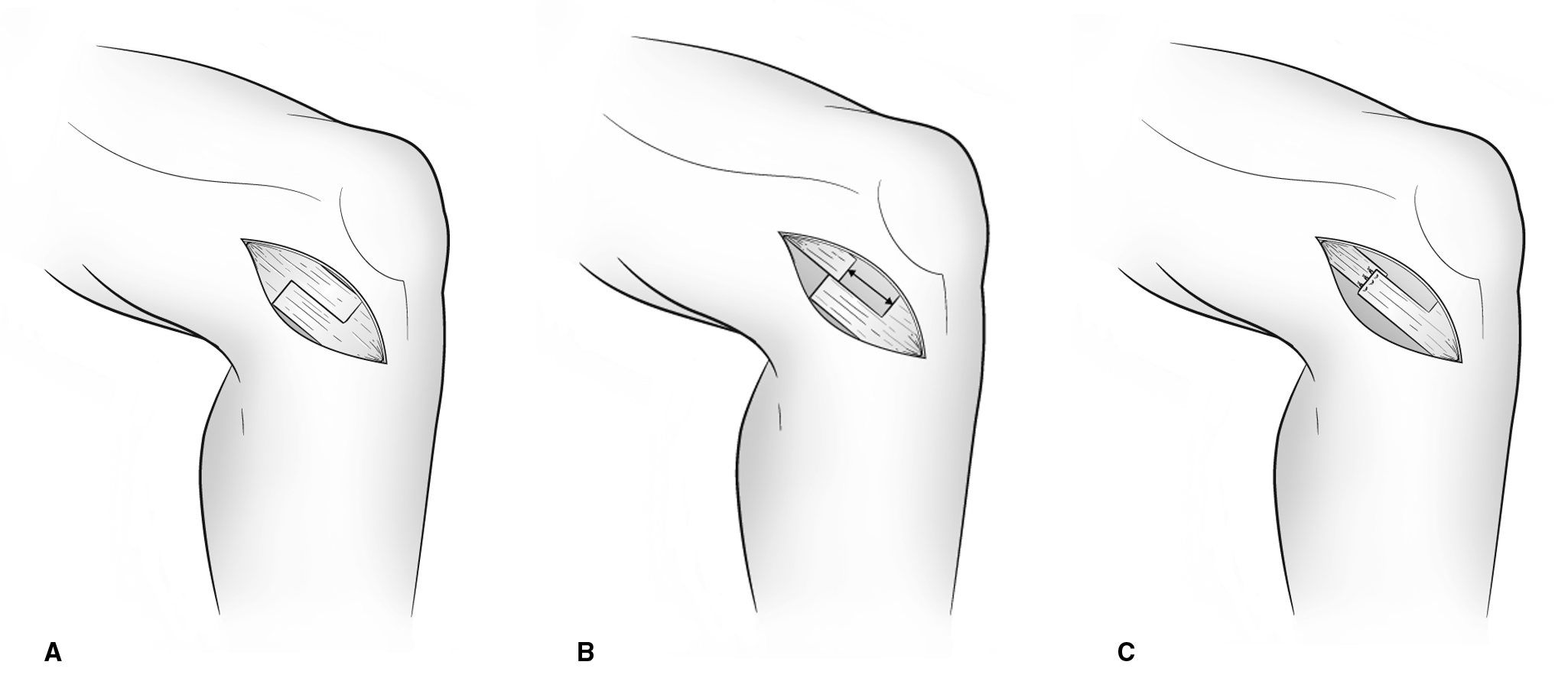Diseases & Conditions
Iliotibial Band (IT Band) Syndrome
IT band syndrome — a common cause of pain in the thigh, knee, and outside of the hip in athletes and runners — is an overuse injury due to repetitive friction of the IT band that runs along the outside portion of the hip and knee. It is usually caused by overtraining and training mistakes, but it can sometimes be due to natural physical conditions that result in skeletal misalignment.
IT band syndrome very rarely requires surgery. It is commonly managed with rest, physical therapy, and gradual return to activity.
Anatomy
The iliotibial (IT) band is a thick band of connective tissue fibers (fascia) that runs along the outside of the thigh between the hip and the knee.
The main function of the IT band is to help stabilize the hip and knee joint while walking or running.
Description
IT band syndrome occurs when the IT band becomes irritated, usually due to excessive friction between the IT band and the outside (lateral side) of the knee. As a result, the slippery fluid-filled sac (bursa) that helps the IT band glide over the bony prominence (bump) at the outside of the knee becomes inflamed, causing pain.
The IT band can also rub on the outside of the hip at the greater trochanter, which results in trochanteric bursitis, or inflammation of the bursa at the side of the hip bone.
Cause
IT band syndrome is an overuse injury that commonly occurs in runners, cyclists, and other athletes who perform activities that require repetitive flexing of the knee.
The most common risk factors for IT band syndrome are improper training techniques and predisposing physical conditions — conditions that make you more vulnerable to an injury. Examples of these include:
Training Mistakes:
- Sudden increase in volume and intensity of training
- Poor shoe support
- Not enough rest time to allow the body to recover
- Running on training surfaces that are not flat (i.e., banked surfaces, uneven curves)
- Lack of stretching and cross training
Physical Conditions:
- Differences in leg lengths
- Bowed legs
- Knee arthritis
- Weak abdominal, hip, and buttock muscles
- Lack of flexibility and tight muscles in the legs
Symptoms
IT band syndrome is often associated with activity-related knee pain that gets better after rest. Common complaints include:
- Stiffness, aching, and burning on the outside of the knee and hip
- Clicking and popping on the outside of the knee and the hip joint
- Pain that radiates up and down the entire length of the leg
Doctor Examination
Medical History and Physical Examination
Your doctor will perform a history and physical exam to determine your symptoms, what worsens them, and what makes them feel better.
They will ask you:
- How long you have had your symptoms
- If you participate in activities that require frequent running or jumping
- If you have pain anywhere else in your body
During the physical exam, they will:
- Look for any bruising; swelling; leg length discrepancies; and misalignment of your hips, legs, and feet
- Palpate (examine by touch) your knee joint, thigh, and hip to determine exactly where your pain is located
- Evaluate the range of motion in your hip and knee joints
In addition, you may be asked to lay on your unaffected side, flex your top knee, and move your leg from in front of your body to behind it and lower your leg down. This test, called the Ober test, will help your doctor determine the amount of tightness in the IT band.
Imaging Tests
After a history and physical exam, your doctor may perform a series of imaging tests to aid in diagnosing the cause of your symptoms.
X-rays. X-rays create clear pictures of dense structures like bone. Your doctor may order an X-ray of your knee or hip to rule out other conditions, such as arthritis, that could be causing similar symptoms. They will also examine the X-ray to see if you have any medical conditions that commonly contribute to IT band syndrome, such as misalignment of the knee.
Magnetic resonance imaging (MRI) scans. In addition to X-rays, your doctor may also have you undergo an MRI scan to help rule out other soft-tissue conditions. An MRI scan may also reveal specific changes in the IT band and its surrounding structures.
Treatment
Nonsurgical Treatment
IT band syndrome is most commonly managed with nonsurgical methods.
Non-Steroidal Anti-inflammatory Drugs (NSAIDs)
Along with rest and ice, your doctor may recommend use of an NSAID like ibuprofen to help alleviate your pain and reduce inflammation.
Injections
If rest, ice, and NSAIDs are not effective, your doctor may inject the affected area with a corticosteroid.
Physical Therapy
Physical therapy, frequently used to both treat and prevent the progression (worsening) of IT band syndrome, involves stretching and strengthening the IT band and other muscles that surround the knee and the hip.
In addition, physical therapists usually recommend that runners:
- Cross train
- Stretch regularly
- Strengthen the hip muscles
- Change their running shoes every 300 to 500 miles
- Avoid sudden increases in distance
Surgical Treatment
Occasionally, when nonsurgical management fails, arthroscopic or open surgery may be required. The cause of IT band syndrome will ultimately determine which surgical method is used.
Soft-Tissue Excision
In patients who have excess or inflamed soft tissue surrounding the hip due to the friction of the IT band, the bursal tissue can be excised (removed) arthroscopically.
During arthroscopy, your doctor will make tiny incisions to insert a small camera and instruments into the joint or surrounding area. They will then remove the inflamed bursa and part of the IT band.
IT Band Excision
In some cases, your doctor may choose to perform a partial excision of the IT band.
- They will make an incision on the outside portion of the knee or hip and remove the inflamed, degenerative (worn down) portion of the IT band.
- Following removal, the skin is repaired with sutures or staples.
IT Band Lengthening
Alternatively, your doctor may lengthen the IT band to reduce the friction near the knee and hip. During this procedure:
- Your doctor will make a small incision, typically over the skin of the hip.
- After identifying the IT band, they will make a z-shaped incision near the middle of the band. This will enable lengthening of the IT band fibers and allow the IT band to pass more easily over the knee.
- The fibers are then repaired, and the skin is closed.
Recovery
- Recovery in patients with IT band syndrome who have been treated with conservative methods depends largely on the severity and duration of their condition. However, most patients are able to recover and return to running within 6 weeks of treatment.
- Recovery in patients who undergo surgery may take up to 3 months. It is recommended that athletes return to their activity gradually. Returning too soon can lead to persistent symptoms and a potential risk of other injuries.
Contributed and/or Updated by
Peer-Reviewed by
AAOS does not endorse any treatments, procedures, products, or physicians referenced herein. This information is provided as an educational service and is not intended to serve as medical advice. Anyone seeking specific orthopaedic advice or assistance should consult his or her orthopaedic surgeon, or locate one in your area through the AAOS Find an Orthopaedist program on this website.










